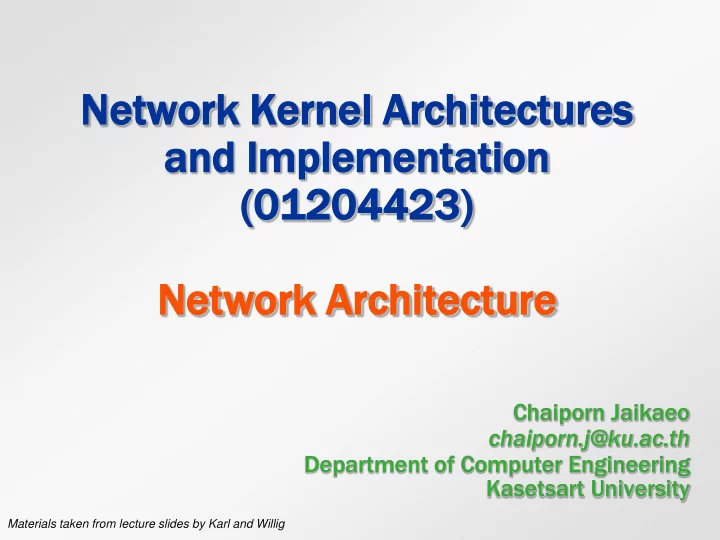

Net etwork work Ke Kerne nel l Ar Archi chitect tectures ures an and d Im Impl plementa ementation tion (01 0120 20442 4423) ) Net etwork work Ar Archi chite tecture cture Chaiporn Jaikaeo chaiporn.j@ku.ac.th Department of Computer Engineering Kasetsart University Materials taken from lecture slides by Karl and Willig
Outline Out line Ne Netwo twork rk sc scena nari rios os Optimization goals Design principles Gateway concepts 2
Typi Ty pical cal Vi Views ws of f WS WSN Self-organizing mobile ad hoc networks (MANETs) Peer-to-peer networks Multi/mobile agent systems and swarm intellegence 3
Sens nsor or Ne Netw twork rk Sce cena narios rios Sour urces ces : Any entity that provides data/measurements Sin inks : Nodes where information is required Source Source Source Sink Sink Sink Internet 4
Sin ingle gle-Hop Hop vs. . Mul ulti ti-hop hop Multi-hop networks Send packets to an intermediate node Intermediate node forwards packet to its destination Store re-and and-fo forward rward multi-hop network Store & forward multi-hopping NOT the only possible solution E.g., collaborative Sink networking, network coding Source Obstacle 5
Mu Multi lti-hopping hopping Al Alwa ways ys Ef Effi fici cient? nt? Obvious idea: Multi-hopping is more energy- efficient than direct communication Suppose we put a relay at distance d /2 Energy for distance d is reduced from cd to 2 c ( d /2) c - some constant - path loss coefficient ( 2) Usually wrong, or over-simplified Need to take constant offsets for powering transmitter, receiver into account 6
Mu Multiple ltiple Sin inks, ks, Mu Mult ltiple iple sou ources rces 7
Out Outline line Network scenarios Optimization timization go goals ls Design principles Gateway concepts 8
Go Goal: al: Qua Quali lity ty of f Serv rvic ice QoS in WSN is more complicated (compared to MANET) Event detection/reporting probability Event classification error, detection delay Probability of missing a periodic report Approximation accuracy (e.g, when WSN constructs a temperature map) Tracking accuracy (e.g., difference between true and conjectured position of the pink elephant) Related goal: robustness Network should withstand failure of some nodes 9
Go Goal: al: En Energ rgy y effi ffici ciency ncy Many definitions Energy per correctly received bit Energy per reported (unique) event Delay/energy tradeoffs Network lifetime Time to first node failure Network half-life (how long until 50% of the nodes died?) Time to partition Time to loss of coverage Time to failure of first event notification 10
Sha harpe rpening ning th the Dr Drop Sacrifice long lifetimes in return for an improvement in short lifetimes 11
Outline Out line Network scenarios Optimization goals Desi sign gn prin inciples iples Gateway concepts 12
Di Distr tributed ibuted Or Organ ganization ization WSN participants should cooperate in organizing the network Centralized approach usually not feasible Potential shortcomings Not clear whether distributed or centralized organization achieves better energy efficiency Option: “limited centralized” solution Elect nodes for local coordination/control Perhaps rotate this function over time 13
In In-Ne Network twork Pro roce cessing ssing WSNs are expected to provide information Gives additional options E.g., manipu pulate late or proc ocess the data in the network Main example: aggregation Apply aggregation functions to a collection tree in a network Typical functions: minimum, maximum, average, sum, … Not amenable functions: median 14
Ag Aggr gregation gation Ex Exam ample ple 1 1 1 1 3 1 1 1 6 1 1 1 15
Sig ignal nal Pro rocess cessing ing Another form of in-network processing E.g., Edge detection Tracking/angle detection of signal source Exploit temporal poral and sp spatial tial correlation elation Observed signals might vary only slowly in time Signals of neighboring nodes are often quite similar Compressive sensing 16
Ada Adapt ptiv ive e Fi Fide delity lity Adapt data processing effort based on required accuracy/fidelity E.g., event detection When event occurs, increase rate of message exchanges E.g., temperature When temperature is in acceptable range, only send temperature values at low resolution When temperature becomes high, increase resolution and thus message length 17
Da Data ta Cent ntric ric Ne Netw twork rking ing Interactions in typical networks are addressed to the id ident ntit ities ies of nodes Known as node-centric or address-centric networking paradigm In WSN, specific source of events might not be important Several nodes can observe the same area Focus on data/results instead Data-centri centric c networ orking ng Principal design change 18
Im Impl plementa ementation tion Opt Optio ions ns Publish/subscribe (NDN – Named Data Networking) Nodes can publ blish data, can subs bscr cribe be to any particular kind of data Once data of a certain type has been published, it is delivered to all subscribers Databases SQL-based request 19
Out Outline line Network scenarios Optimization goals Design principles Gat ateway eway con oncep epts ts 20
Gate Ga teways ways in in WS WSN/ N/MANET MANET Allow remote access to/from the WSN Bridge the gap between different interaction semantics E.g., data vs. address-centric networking Need support for different radios/protocols 21
WSN WS N tu tunne nneling ling Use the Internet to “tunnel” WSN packets between two remote WSNs Internet Gateway Gateway nodes 22
6Lo LoWPAN WPAN IPv6 over Lo Low-power Wireless Personal Area Networks Nodes communicate using IPv6 packets An IPv6 packet is carried in the payload of IEEE 802.15.4 data frames 23
Ex Example ample 6Lo LoWPAN WPAN Sys yste tems ms 24
Sum ummary mary Network architectures for WSNs look quite different from typical networks in many aspects Data-centric paradigm opens new possibilities for protocol design 25
Recommend
More recommend